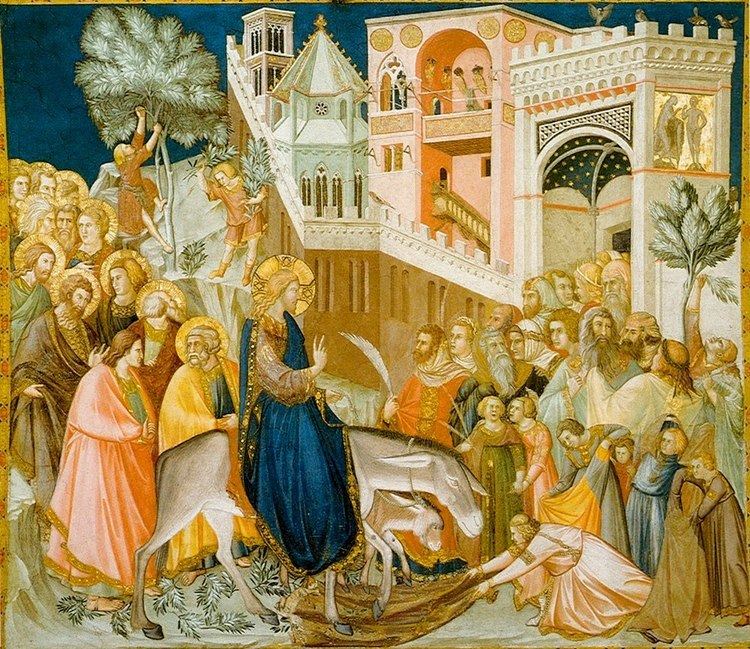 | ||
In the accounts of the four canonical Gospels, Jesus' triumphal entry into Jerusalem takes place in the days before the Last Supper, marking the beginning of his Passion.
Contents
Crowds gather around Jesus and believe in him in John 12:9-11 after he raised Lazarus from the dead, and the next day the multitudes that had gathered for the feast in Jerusalem welcome Jesus as he enters Jerusalem.
In Matthew 21:1-11, Mark 11:1-11, Luke 19:28-44, and John 12:12-19, Jesus descends from the Mount of Olives towards Jerusalem, and the crowds lay their clothes on the ground to welcome him as he triumphantly enters Jerusalem.
Christians celebrate Jesus' entry into Jerusalem as Palm Sunday, a week before Easter Sunday.
Gospel accounts
According to the Gospels, Jesus was staying at Bethany and Bethphage before entering Jerusalem. John 12:1 states that he was in Bethany six days before the passover. In the synoptic gospels, Jesus sends two disciples ahead to the village over against them in order to retrieve a donkey (or, in Matthew, two animals: a donkey and a colt) that had been tied up but never ridden, and to say, if questioned, that the donkey was needed by the Lord (or Master) but would be returned.
Jesus then rode the donkey into Jerusalem, with the three Synoptic gospels stating that the disciples had first put their cloaks on it (presumably to make it more comfortable). Matthew 21:7 maintains that the disciples laid their cloaks on both animals: they brought the donkey and the colt, laid their clothes on them, and set Him (or he sat) on them. Heinrich Meyer suggests that "they spread their outer garments upon both animals, being uncertain which of them Jesus intended to mount".
In Luke 19:41 as Jesus approaches Jerusalem, he looks at the city and weeps over it (an event known as Flevit super illam in Latin), foretelling the suffering that awaits the city.
The Gospels go on to recount how Jesus rode into Jerusalem, and how the people there lay down their cloaks in front of him and also lay down small branches of trees. The people sang part of Psalm 118: 25-26: Blessed is He who comes in the name of the Lord. We bless you from the house of the Lord ....
On his entry into the city, Matthew's account suggests that Jesus evoked great excitement - "all the city was moved" - but also that Jesus may not have been known to the people of Jerusalem: the people of the city asked "Who is this?" and "the multitudes" (Greek: οι οχλοι, hoi ochloi) answered, "This is Jesus, the prophet from Nazareth of Galilee”.
The word "moved" in the Greek text is "ἐσείσθη" (eseisthē), derived from σεισμός (seismos). The Cambridge Bible for Schools and Colleges suggests "the word in the original is forcible, “convulsed” or “stirred” as by an earthquake, or by a violent wind". Matthew uses the same word in 27:15 when he suggests that the earth "quaked" at the time of Jesus' death.
In the Synoptic Gospels, this episode is followed by the Cleansing of the Temple episode and, in all four Gospels, Jesus performs various healings and teaches by way of parables while in Jerusalem until the Last Supper.
Traditionally, entering the city on a donkey symbolizes arrival in peace, rather than as a war-waging king arriving on a horse.
Old Testament parallels
Matthew 21:1-11 refers to a passage from Book of Zechariah (9:9) and states:
"All this was done, that it might be fulfilled which was spoken by the prophet, saying, Tell ye the daughter of Sion, Behold, thy King cometh unto thee, meek, and sitting upon an ass, and a colt the foal of an ass."The location of the Mount of Olives is significant in the Old Testament in that Zechariah 9:9 and Zechariah 14:1-5 stated that the Messiah would come to Jerusalem from the Mount of Olives:
Then shall the Lord go forth and fight against those nations, as when he fought in the day of battle. And his feet shall stand in that day upon the Mount of Olives, which is before Jerusalem on the east.The triumphal entry and the palm branches, resemble the celebration of Jewish liberation in 1 Maccabees (13:51) which states:
And entered into it ... with thanksgiving, and branches of palm trees, and with harps, and cymbals, and with viols, and hymns, and songs.Jesus' entry on a donkey has a parallel in Zechariah 9:9 which states that:
thy king cometh unto thee; he is just, and having salvation; lowly, and riding upon an ass.The symbolism of the donkey may also refer to the Eastern tradition that it is an animal of peace, versus the horse, which is an animal of war. Therefore, a king came riding upon a horse when he was bent on war and rode upon a donkey when he wanted to point out that he was coming in peace. Therefore, Jesus' entry to Jerusalem symbolized his entry as the Prince of Peace, not as a warmongering king.
